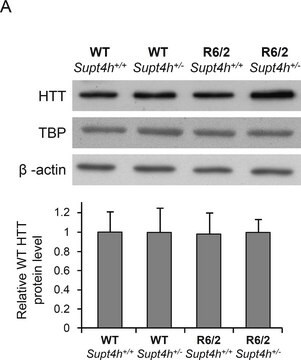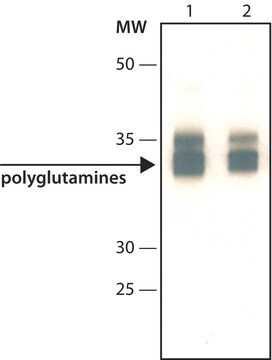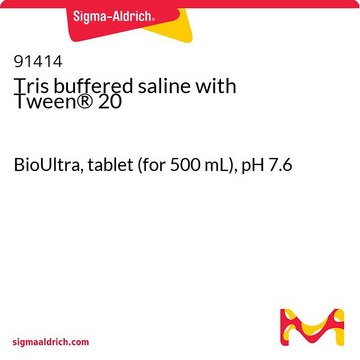MAB5360
Anti-Spinocerebellar Ataxia Type 3 Antibody, clone 1H9
ascites fluid, clone 1H9, Chemicon®
Synonym(s):
Ataxin-3, josephin
About This Item
Recommended Products
biological source
mouse
Quality Level
antibody form
ascites fluid
antibody product type
primary antibodies
clone
1H9, monoclonal
species reactivity
rat, human, monkey, mouse
manufacturer/tradename
Chemicon®
technique(s)
ELISA: suitable
immunocytochemistry: suitable
immunohistochemistry: suitable
immunoprecipitation (IP): suitable
western blot: suitable
isotype
IgG1
NCBI accession no.
UniProt accession no.
shipped in
dry ice
target post-translational modification
unmodified
Gene Information
human ... ATXN3(4287)
General description
Spinocerebellar ataxia (SCA) is one of a group of genetic disorders characterized by slowly progressive incoordination of gait and often associated with poor coordination of hands, speech, and eye movements. Frequently, atrophy of the cerebellum occurs. The first ataxia gene was identified in 1993 for a dominantly inherited type called “Spinocerebellar ataxia type 1" (SCA1). Subsequently, as additional dominant genes were found they were called SCA2, SCA3, etc. Usually, the "type" number of "SCA" refers to the order in which the gene was found. At this time, there are at least 29 different gene mutations which have been found.
Specificity
Immunogen
Application
A 1:500-1:5000 dilution of a previous lot was used in IH.
Immunoprecipitation:
A 1:500-1:5000 dilution of a previous lot was used in IP.
ELISA:
A 1:500-1:5000 dilution of a previous lot was used in ELISA.
Immunocytochemistry:
A 1:500-1:5000 dilution of a previous lot was used in IC.
Optimal working dilutions must be determined by the end user.
Quality
Western Blot Analysis:
1:500 dilution of this antibody detected SPINOCEREBELLAR ATAXIA 3 on 10 µg of NIH/3T3 lysates.
Target description
Analysis Note
Human SCA-3/MJD brain sections, NIH/3T3 lysate
Other Notes
Legal Information
Not finding the right product?
Try our Product Selector Tool.
Storage Class Code
10 - Combustible liquids
WGK
nwg
Flash Point(F)
Not applicable
Flash Point(C)
Not applicable
Regulatory Listings
Regulatory Listings are mainly provided for chemical products. Only limited information can be provided here for non-chemical products. No entry means none of the components are listed. It is the user’s obligation to ensure the safe and legal use of the product.
JAN Code
MAB5360:
Certificates of Analysis (COA)
Search for Certificates of Analysis (COA) by entering the products Lot/Batch Number. Lot and Batch Numbers can be found on a product’s label following the words ‘Lot’ or ‘Batch’.
Already Own This Product?
Find documentation for the products that you have recently purchased in the Document Library.
Our team of scientists has experience in all areas of research including Life Science, Material Science, Chemical Synthesis, Chromatography, Analytical and many others.
Contact Technical Service







